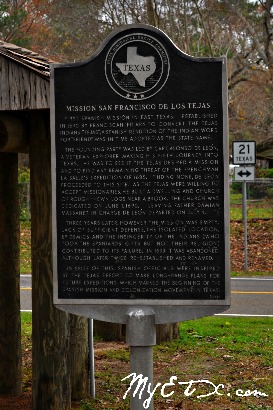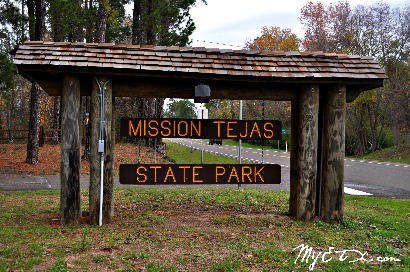|
|
Houston
County - East
Texas is full of amazing history and natural beauty. Mission Tejas
State Park fully encompasses both the rich history of East
Texas and the natural wonder and beauty of the Pineywoods and
affords visitors the chance to experience both to the fullest extent.
Mission Tejas State Park is a 363.5-acre park nestled in Houston
County, 21 miles northeast of Crockett.
The park was constructed in 1935 and acquired in 1957 by Legislative
Act from the Texas Forest Service, at which time it was open to the
public.
The park was built in 1934 by Company 888 of Civilian Conservation
Corps (CCC) as a commemorative representation of Mission
San Francisco de los Tejas, the first Spanish mission in the province
of Texas, which was established in 1690.
San Francisco means “Saint Francis.” St. Francis of Assisi was born
in 1181 and died in 1226. His influence assisted in the restoration
of popular faith in the church which had been corrupted by wealth
and politics. Saint Francis was the founder of the Franciscan religious
order whose members seek to follow a life of poverty and devoutness.
He was declared a saint by the Roman Catholic Church on July 16, 1228.
The mission was constructed to bring Christianity to the Indians dwelling
in the Pineywoods and
to secure Spain’s domination over the territory, which would eventually
become the great state of Texas. The
mission served as a reminder for France, which occupied nearby Louisiana,
that the territory belonged to Spain.
Tejas was the Spanish pronunciation the Caddoa Indian word meaning,
“friends.” The Lone Star State takes its name from the term “Tejas.”
The mission became a stopping point for many adventurers and explorers
such as Rene
Robert Cavelier, Sieur de La Salle during the late 1660s. La
Salle led the Spanish effort to settle with colonists and deny
the French entry, thus establishing sovereignty over the area. In
1683, La
Salle returned to France to gain permission for his colonization
plans and received the support he needed to proceed. In 1684, La
Salle left France and unintentionally landed at Matagorda
in 1685. La
Salle had intended to land near the mouth of the Mississippi River,
but irtonically misread his map, thus landing on the Texas
coast. Spain reacted defensively to La
Salle’s mistake and launched a manhunt aimed at La
Salle.
It was at this time when Father Damian Massanet, a Franciscan friar,
was assigned the task of inaugurating missionary activity among the
East Texas Indians. Officials in the capital concluded that military
presence would impede upon their mission of spreading the Gospel.
In light of this, a proposed system of forts to bridge the gap between
settlements in Coahuila and a new mission field were rejected. Rather,
Massanet founded San
Francisco de los Tejas, which became the first mission in East
Texas, known as Mission
Tejas.
The Spanish faced a long and perilous journey from Mexico to East
Texas. They had to trek some 700 miles in order to supply the
mission. The path these early travelers used eventually became known
as the El
Camino Real, otherwise known as the Royal Road or the King’s Highway.
The El Camino
Real de los Tejas was originally a Native American footpath that
adapted over time as the frontier expanded. The path eventually facilitated
Spanish exploration into present day Louisiana, and even later Anglo
settlers heading southwest.
In 1694, the mission
was abandoned. The mission
was extremely difficult to supply due to the long distance. Factors
regarding the Native American Indians also played a role on the abandonment
of the mission.
Illness and death among Native Americans as well as their belief that
baptismal waters were fatal, and missionary fatalities led people
not to congregate at the mission.
Nearly 30 years later, in 1721, the mission was reestablished by Friar
Jose Guerra. The mission was renamed San Francisco de los Neches.
Approximately nine years after the mission was reestablished, the
French were no longer a threat, however, there were very few Native
American converts. It was still very difficult to supply the mission
due to the great distance, and therefore was abandoned again. |
 |
Mission Tejas
Historical Marker
Click on photo for large image
Photo
courtesy Dana Goolsby,
2011 |
|
Early
settlers who traveled the El Camino Real de los Tejas were Moses
Austin and later his son, Stephen
F. Austin. Other Texans who traveled the trail include Sam
Houston, Jim Bowie and Davy Crockett.
Time marched
on and eventually more settlers arrived and constructed a log home.
Joseph Redmond Rice Sr. and his wife Willie Masters relocated to
Texas from Tennessee in 1828 and were
among the earliest settlers of Houston County. The Rice’s were a
large family of 13. Rice became a self-sufficient and prosperous
farmer in Houston County after securing a grant of 1,237 acres of
land in 1841 from the Republic of Texas.
The home which Rice constructed between 1828 and 1838, is one of
the oldest structures in East
Texas. The home served as a stopover for immigrants, adventurers,
and local residents traveling the El
Camino Real. The log home was originally built 16 miles southwest
of the park.
After Rice’s death in 1866, his wife continued to live in the log
home until her death in 1881. Family members occupied to log house
until 1919. Rice’s grandson, John Rice, relocated the house between
1919 and 1928, in order to use it as a garage or barn. After John
Rice passed away his wife, Nancy Rice donated the log house to the
state. In 1974, the log house was restored and moved to its current
location in the park.
|
 |
|
Mission Tejas
State Park
Photo
courtesy Dana Goolsby,
October 2010
|
|
Mission
Tejas State Park offers several activities including camping, picnicking,
hiking, and fishing. A pond located near the picnic area offers
an excellent opportunity to explore aquatic life and fish. Hiking
and nature trails provide access to the natural beauty of the East
Texas Pineywoods. Facilities include commemorative representation
of Mission San Francisco de los Tejas; the restored Rice Family
Log Home; picnic sites; campsites with water; campsites with water
and electricity; campsites with water, electricity, and sewer; group
picnic areas; a group picnic pavilion; restrooms with and without
showers; a group camping area; an amphitheater; a trailer dump station;
3 1/2 miles of hiking trails; a playground; and a nature pond (approximately
1 acre in size).
Nearby attractions include Caddo
Mounds State Historic Site and the Davy Crockett National Forest.
Mission Tejas
State Park is located 21 miles northeast of Crockett
and 12 miles southwest of Alto
on State Highway 21. For reservations contact 512.389.8900 or for
more information contact 800.792.1112 or 936.687.2394 or visit the
state park website at www.tpwd.state.tx.us/missiontejas.
Elevation: Elevation ranges from 167 to 552 feet.
Weather: Average rainfall 42.2 inches. January average low
is 35 degrees. July average high is 95 degrees.
Schedule: Open 7 days a week year-round. Office Hours: 8
a.m. to 5 p.m., 365 days a year.
© Dana
Goolsby
This
article was originally published on MYETX.com
"In The Pines With Dana
Goolsby"
April 20, 2012 Column
|
|
|